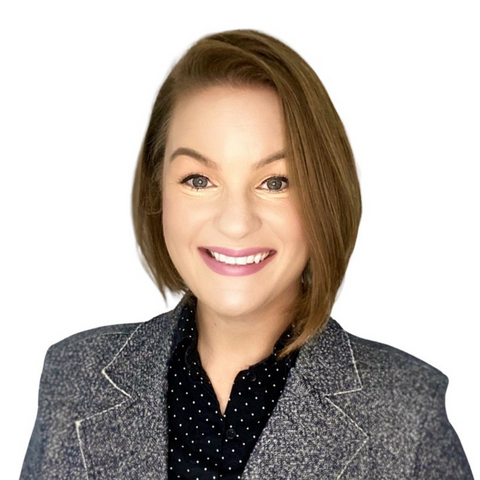We hire people for skills, but skills decay over time, and the skills needed to remain competitive are constantly evolving.
Currently, there's a significant gap between in-demand skills and employees with those abilities, especially in industries such as manufacturing, IT, and healthcare.
Running a skills gap analysis is among the most efficient methods to identify and address these problems.
What is a Skills Gap Analysis?
A skills gap analysis is a method organizations use to track and measure the gap between the abilities and competencies they require and those their workforce currently possesses.
HR departments and leaders evaluate current employees' skill sets to gauge their work performance and determine whether they have the necessary capabilities and knowledge to reach strategic goals and keep up with emerging trends.
A skills gap analysis is an excellent way for employers to:
- Understand their workforce's potential.
- Identify gaps that could hinder business longevity in the long run.
- Discover tools and insights to implement proper recruitment strategies.
- Create learning and development programs.
- Offer upskilling opportunities.
It's recommended to conduct a skills gap analysis every three to six months, or when your strategy changes, or if you notice any performance gaps.
With AI-powered recruiting systems, companies can perform a more accurate skills gap analysis, ensuring better talent alignment.
Examples of a Skills Gap Analysis
The idea of executing a skills gap analysis has grown in importance, but it's nothing new. Here are a few examples from recent history where companies have had to do this.
AT&T
In the mid 2010s, AT&T embarked on a massive skills gap analysis to address the rapid changes that were happening in the telecommunications industry, particularly the shift toward digital and cloud-based services.
In response, AT&T launched its “Workforce 2020” initiative to rethink how it prepared employees for the future.
The company used a combination of internal surveys, performance data, and market trend analyses to determine which skills were lacking across its workforce. They identified gaps in digital skills, data science, and cybersecurity.
The solution was a major investment in retraining AT&T's workforce. They introduced an online platform offering courses in software development, data analysis, and other in-demand areas, partnering with organizations like Udacity and Georgia Tech for certifications and degrees. The effort was later rebranded as "Future Ready" to show their commitment to training workers for life beyond 2020.
Amazon
Amazon faced a growing need for specialized technical skills across various sectors, especially in machine learning, cloud computing, and robotics, to support its expansion in fulfillment and logistics.
The company used data from performance reviews, market research, and future industry projections to assess current skill levels and forecasted needs. They identified significant gaps in areas like data science, cloud engineering, and robotics.
To solve for this, Amazon launched its “Upskilling 2025” initiative, committing $700 million to retrain 100,000 employees in relevant technical skills. The program includes offerings such as the Amazon Technical Academy, focusing on software engineering skills, and Machine Learning University, which teaches advanced data science and machine learning.
The program has since been expanded and offers a variety of learning pathways for employees.
Verizon
Verizon identified a skills gap in its workforce, particularly in technical roles. To address this, Verizon launched the "Verizon Thrive" apprenticeship program, a 12-month earn-and-learn initiative designed to train individuals in essential technical skills required for various positions within the company.
Upon completion, 95% of the first cohort accepted full-time employment offers from Verizon, demonstrating the program's effectiveness in bridging the skills gap and enhancing the company's talent pool.
"Apprenticeship is a great tool we could harness to address skill gaps," Ryan Craig, author of Apprentice Nation said on an episode of the People Managing People podcast. "It's not just a training program. And it's not a program that requires you to pay tuition or take on debt or take any financial risk. Apprenticeships are by definition a job, and it's a job that pays a living wage with built-in training, with built-in wage increases as you become more productive and a built-in career path."
How to Conduct a Skills Gap Analysis
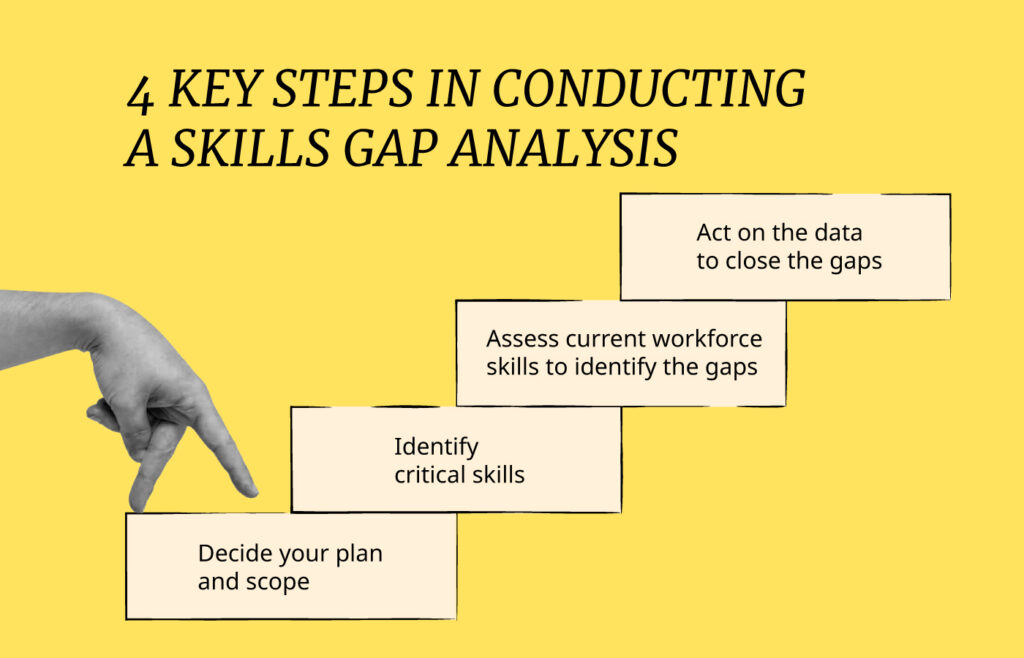
1. Decide Your Plan and Scope
You must first decide who will oversee this process, when you will conduct it, who you'll include in the evaluation, and how it will unfold.
The two most common levels a skills gap analysis assesses are:
- Individual level—you can pinpoint the skills and abilities each job role requires and how they compare to a worker's current skills inventory.
- Company or team level—you can also determine whether your team or a company as a whole has the necessary capabilities and knowledge to complete a project, or if you must turn to external recruitment.
Senior team leaders are more suitable for individual assessments, while HR or external consultants are better for team evaluations.
Choosing an outside professional helps maintain objectivity and ensures hiring managers, team leaders, and HRs can work on their tasks.
Conducting a skills gap analysis is easier with employee evaluation tools that identify areas for improvement.
What form of a skills gap will you perform?
The next step is to decide on the form of the skills gap analysis. Options include:
- Performance reviews
- Surveys
- Employee interviews
- Skills management platforms
- Pre-employment tests.
- 360-degree feedback
- Behavioral assessments
- Job knowledge evaluations.
By using recruitment database tools, you can quickly identify candidates who fill specific skill gaps within your team. Running skills tests after employee interviews can help you determine in what career growth opportunities to invest.
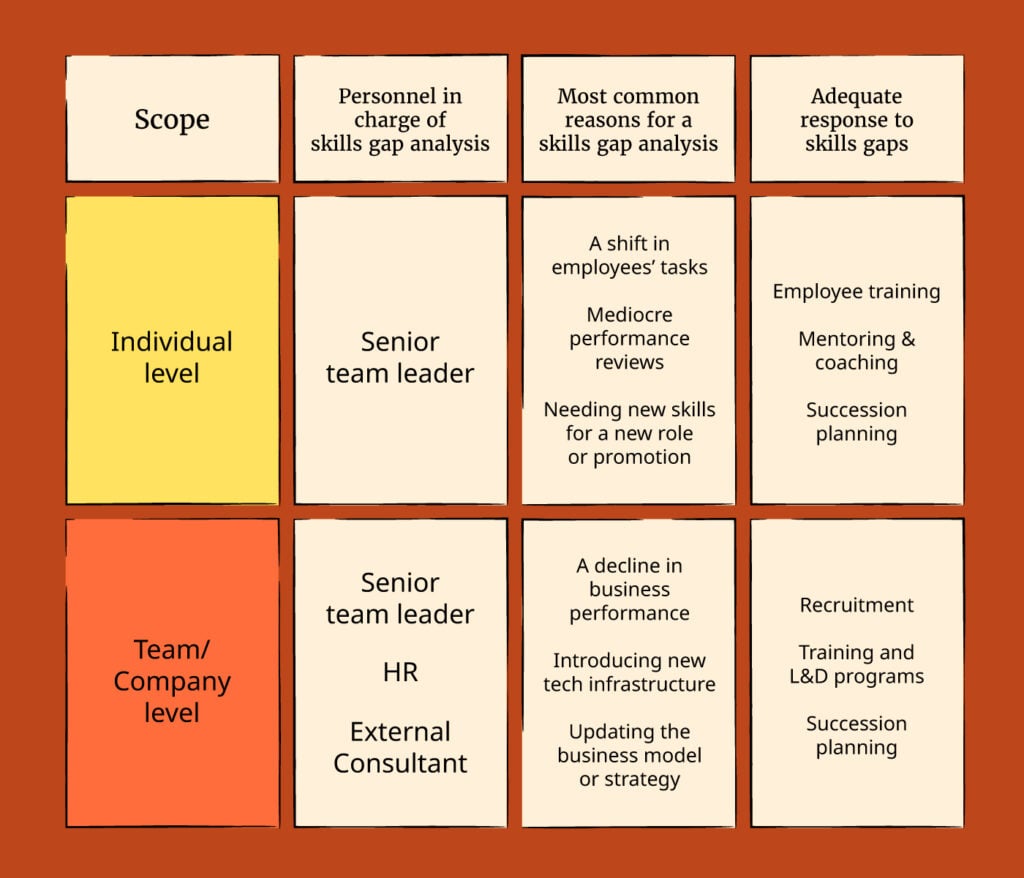
2. Identify Critical Skills
Here you should consider two crucial questions:
- What skills does your company currently perceive as valuable?
- What abilities do workers need to continue to perform their jobs well?
Many employers foster the macro and micro-skills approach.
The former represents the unique way a person operates and includes abilities such as critical thinking, problem-solving and leadership.
The latter are rather technical skills and have a pre-defined learning formula (e.g., code testing).
Hard skills evolve with new technology and industry trends and, therefore, require continuous monitoring.
Soft skills are always revered and necessary, regardless of the sector or company.
Your skills gap analysis can focus separately on these two types of skills. Aim to identify what macro skills your company should start fostering over the following five years and what micro skills would benefit your business now.
Pro Tip
Encourage your employees to share their affinities and what skills they would like to improve or obtain. Involving your workers in the process also shows them you care about their career progress and development.
3. Assess Current Workforce Skills to Identify the Gaps
This step will help you understand whether you should hire new workers or whether training is enough to help your staff obtain the missing capabilities.
Skills assessments are typically the easiest and most effective method to do this.
Create assessments tailored to your company and industry needs, such as job simulations.
You can also use psychometric tests to analyze soft skill levels, such as emotional intelligence. Combine these insights with employee feedback and performance reviews to clearly understand your workforce's limits, potential, and opportunities.
4. Designing interventions
Once you’ve identified skill gaps, it’s time to create effective strategies to bridge them. Each organization will face unique skill gaps, but a World Economic Forum report highlights that cognitive skills, particularly creative and analytical thinking, are in high demand, with technology literacy close behind.
Similarly, a McKinsey survey shows data analytics as the top area with skill gaps, followed by IT and executive management.
Types of Interventions
Depending on the skills needed and your workforce’s current abilities, here are key approaches to address skill gaps:
Recruiting Critical Skills: Skill gaps may prompt changes in hiring criteria, seeking candidates with the required expertise. If time is limited, you can also turn to independent contractors to temporarily fill skills gaps.
Training and Development: A skills gap analysis can direct your training programs to target specific areas where employees need new skills.
Job Redesign: Reviewing company goals may reveal areas where roles need reshaping to better align with business needs. Job redesign can involve upskilling or reskilling current employees to meet updated requirements.
Train for Skills Gaps
You've identified the skills your people are lacking and which ones are most important for the business, now it's time to train them so you start seeing improvement.
Here are some tips help drive the success of your training efforts.
Develop Targeted Training Programs
- Customized Training Plans: Create training programs tailored to the specific needs identified in the skills assessment. These can range from technical skills to soft skills like leadership and communication.
- Leverage Various Training Methods: Incorporate a mix of training methods such as workshops, e-learning modules, webinars and mentorship programs to cater to different learning styles.
Foster a Culture of Continuous Learning
- Encourage Self-Directed Learning: Empower employees to take charge of their own development by providing access to learning resources and time for self-study.
- Promote Knowledge Sharing: Create opportunities for employees to share their skills and knowledge, enhancing peer-to-peer learning.
Collaborate with Managers and Leaders
- Engage Leadership: Involve managers and leaders in the training process, as they are key in identifying skills gaps and supporting employee development.
- Set Clear Expectations: Ensure that managers understand their role in mentoring and supporting their team members through the training process.
Measure and Adapt Training Efforts
- Track Progress and Impact: Regularly review the effectiveness of training programs, assessing how they are closing skills gaps and contributing to business goals.
- Stay Agile and Flexible: Be prepared to adapt training programs as company needs evolve and new skills gaps emerge.
Invest in Professional Development
- External Training and Education: Consider supporting further education or professional development courses that can bring in new certifications, skills and perspectives.
Hiring for Skills Gaps
For the gaps you can't train, you'll need to take an approach to hiring that supports you strategic workforce planning efforts.
Here are some tips to help you get the most from your recruitment efforts:
Refine Job Descriptions and Requirements
- Specific Skill Sets: Craft job descriptions that clearly outline the specific skills and competencies needed to fill the identified gaps.
- Balance Between Must-Have and Nice-to-Have Skills: Prioritize essential skills while remaining open to candidates who can grow into the role.
Utilize Targeted Recruitment Strategies
- Focused Sourcing: Target specific industries, roles or educational programs where potential candidates with the desired skills are likely to be found.
- Leverage Social Media and Professional Networks: Use platforms like LinkedIn to reach out to candidates who possess niche skills.
Implement Skills-Based Assessments in the Hiring Process
- Assessment Tools: Incorporate practical assessments, case studies or simulations to evaluate candidates' skills effectively.
- Behavioral Interviews: Use behavioral interview techniques to understand how candidates have applied their skills in past situations.
Partner with Educational Institutions and Professional Associations
- Build Relationships: Forge connections with universities, trade schools and professional associations to access a pool of fresh talent.
- Internship and Apprenticeship Programs: Establish programs such as apprenticeships allows students or recent graduates to bring new skills and perspectives to your organization.
Embrace Diversity in Hiring
- Broaden Talent Pools: Diversify your recruitment efforts to include varied demographic and professional backgrounds, bringing a range of skills and experiences.
- Global Talent Acquisition: Consider looking beyond local talent pools to international candidates who can fill specialized roles.
Why Conduct a Skills Gap Analysis?
Skills requirements change fast in nearly every industry globally. This is the principal reason companies must keep track of their workforce's skills inventory.
The World Economic Forum (WEF) found that 1.1 billion jobs are liable to be radically transformed by technology in the next decade, which means many employers will have to address drastic skills gaps in the coming years.
Upskilling and reskilling should be regular practices. An increasing number of people will have to adapt their competencies or adopt new ones during this decade.
The most common reasons to conduct a skills gap analysis are:
- Experiencing a significant decline in business performance and failing to meet financial goals.
- Introducing a new software, tech platform or process.
- Forecasting a market disruption (e.g., automation) that could hinder business performance.
- Wanting to track the loss or addition of abilities and competencies due to workforce movement.
- Pivoting or updating the business model or strategy and requiring data on the workforce's skills inventory.
Benefits of Skills Gap Analysis
Here are the key advantages companies get from conducting a skills gap analysis.
- It allows you to tap into your workforce's skill sets—a skills gap analysis will help you understand how many employees possess the in-demand abilities and knowledge necessary to meet strategic goals and objectives.
- It enhances employees’ learning and development journey— a skills gap analysis will help you build a skills-based learning approach based on what's needed.
- It reinforces strategic workforce planning—among other things, strategic workforce planning ensures you hire the correct number of people with adequate skills and competencies.
- It can boost your hiring efforts—knowing what skills and abilities your future employees should have comes from the data a skills analysis provides.
- It helps reduce costs—gives you data you can use to augment the skills of your existing workforce and promote internal mobility instead of hiring externally.
- It helps foster high-performing teams—ensuring employees acquire the skills necessary to be competitive and efficient improves team performance and productivity.
- It helps you gain a competitive advantage—knowing your workforce’s strengths, potential, and weaknesses is a remarkable competitive advantage that ensures a good employer value proposition.
Skills Gap Analysis Approaches
A standardized skills gap analysis helps identify discrepancies between current and desired skills in an organization. Here are two common approaches:
- Simple Skills Gap Analysis:
A straightforward method using a spreadsheet to compare current skill levels to desired levels. Fields include:
- Employee Name
- Skill (specific to the position or future roles)
- Current Skill Level (rating scale)
- Desired Skill Level (rating scale)
2. Quantitative Skills Gap Analysis:
A more detailed, algorithmic approach that focuses on competencies employees frequently use. This method involves:
- Benchmarking skills for each role, which can be done either top-down or bottom-up.
- Data Collection: Use surveys, self-assessments, or 360-degree feedback.
- Scoring: Rate skills on a scale of 1-5, measuring both skill possession and skill necessity, alongside usage frequency.
This approach is ideal for larger teams and helps prioritize training needs based on skill importance and usage.
Skills Gap Analysis Templates
What does a skills gap analysis actually look like you might ask. Well, don't worry, we've got you covered with some example templates that you can apply straight away.
Let's rein it in from an org wide view and break these down into types of skill gap analysis, individual and team skill gap analysis.
Individual
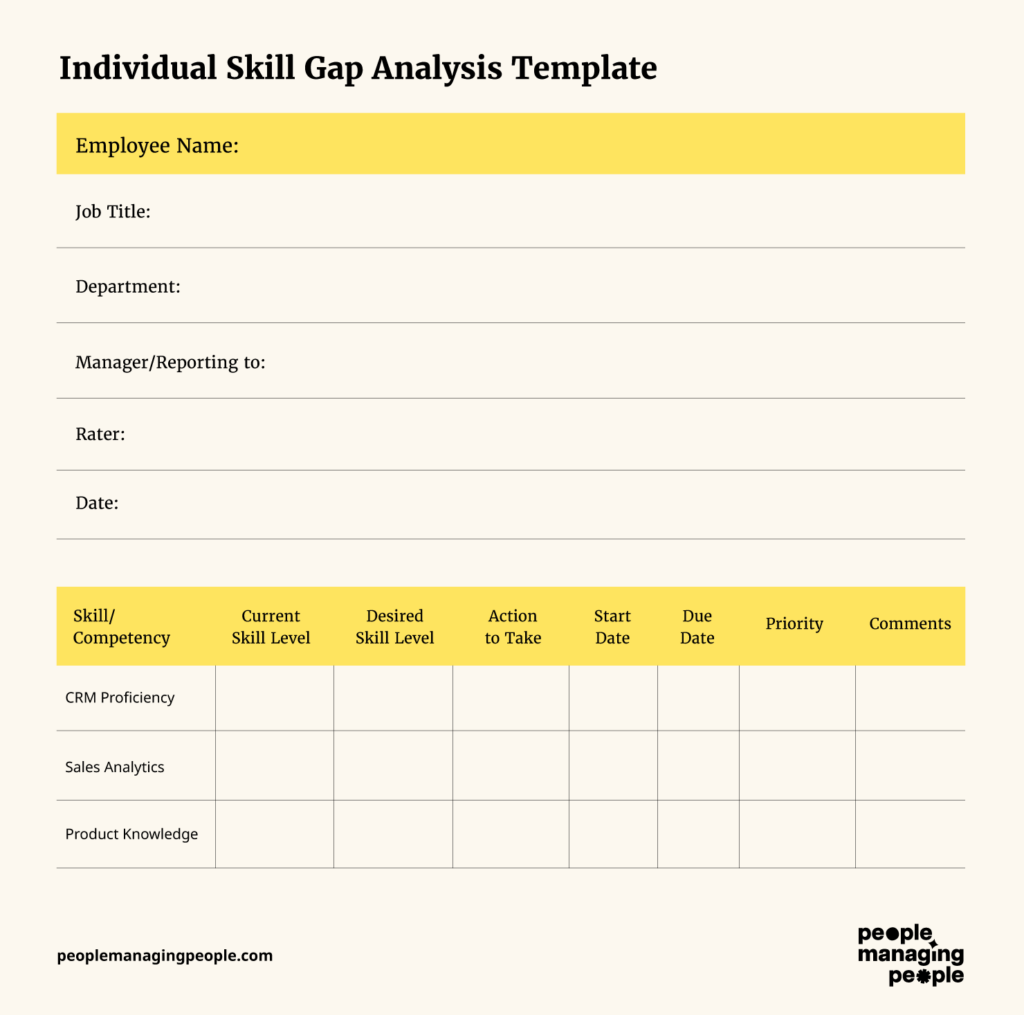
Template instructions
- Basic Information: Fill out the employee’s name, job title, department, manager, rater (the person assessing the skills), and date of the assessment.
- Skill/Competency: List the specific skills or competencies needed for the employee's role. Examples could include “CRM Proficiency,” “Sales Analytics,” or “Product Knowledge.” Read more on the difference in our article on competency-based performance management.
- Current Skill Level: Rate the employee's current skill level for each competency on a consistent scale (e.g., 1-5, where 1 is beginner and 5 is expert).
- Desired Skill Level: Specify the level of proficiency needed for the role or for future growth.
- Action to Take: Outline specific steps to help the employee reach the desired skill level. Actions could include training programs, mentorship, or self-study tasks. Be specific, such as “Enroll in an advanced data analysis course” or “Schedule weekly coaching sessions with the product team.”
- Start Date and Due Date: Specify when each action plan should begin and the expected completion date.
- Priority: Assign a priority level to each skill gap. For example:
- High Priority (e.g., essential to the role)
- Medium Priority (e.g., beneficial but not urgent)
- Low Priority (e.g., for future development)
8. Comments: Use this section for additional notes, such as progress updates, feedback from the employee, or any adjustments to the action plan.
Team
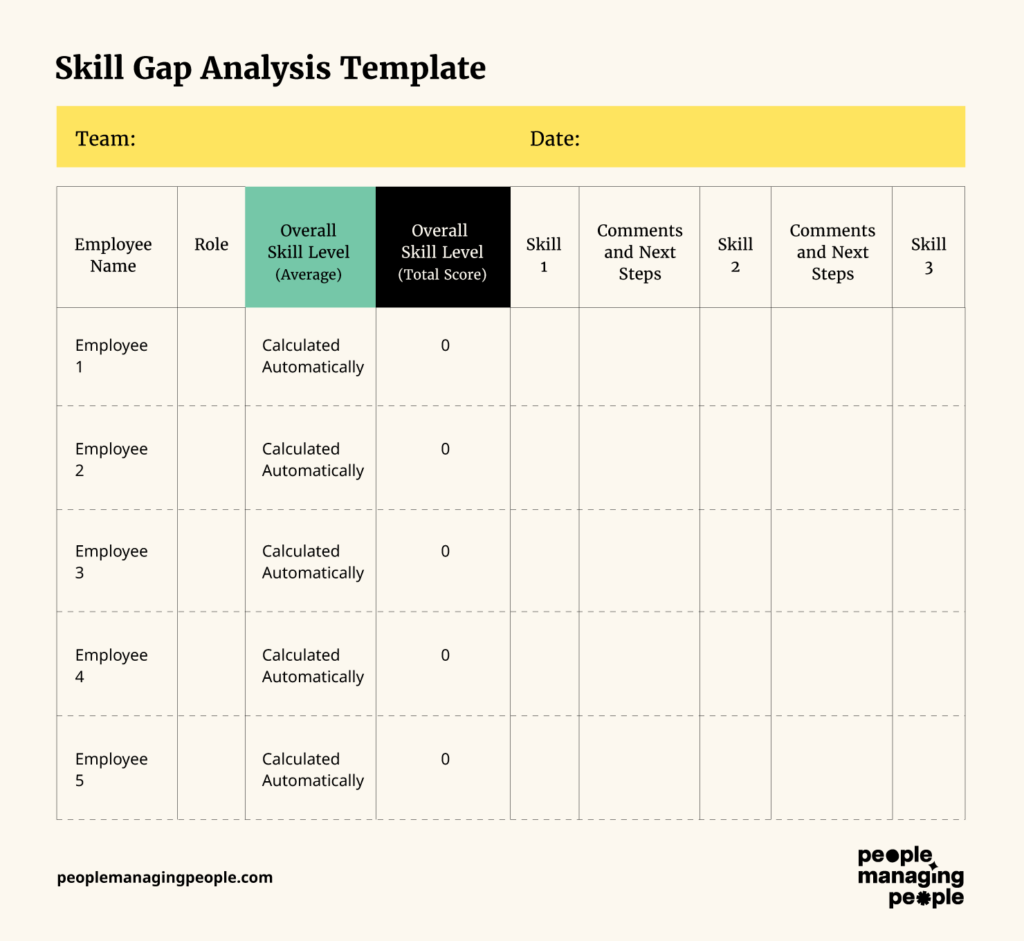
Template instructions:
- Team and Date: Specify the team conducting the analysis and the date.
- Employee Name and Role: Enter each employee's name and role.
- Overall Skill Level: This field will automatically calculate the average skill level score for each employee.
- Skill Fields:
- Enter each specific skill being evaluated (e.g., "Data Analysis" or "Project Management").
- Rate each skill based on a standardized scale (e.g., 1-5).
- Comments and Next Steps:
- For each skill, add comments or suggested actions for improvement.
- Include recommendations for training, coaching, or role adjustments as needed.
For more expert articles on talent management and organizational development, subscribe to the People Managing People newsletter.

